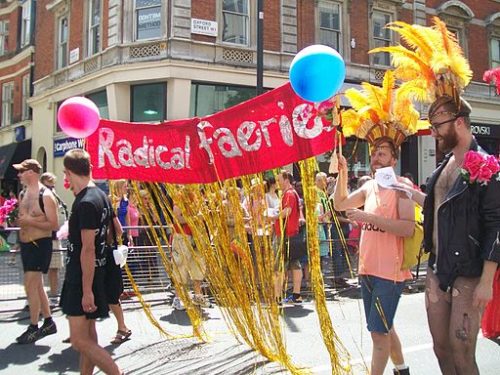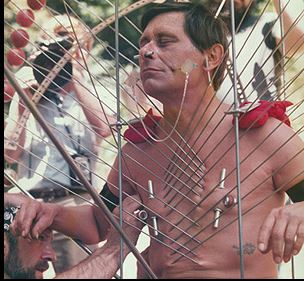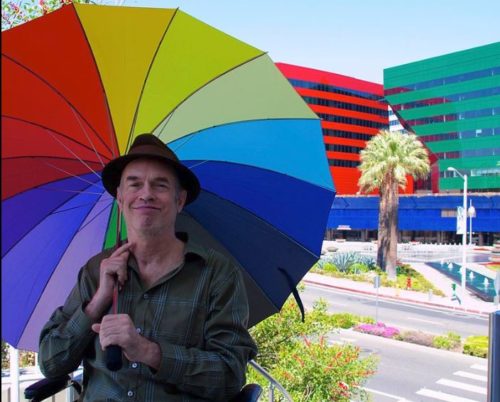TWH- Many people first became involved with Paganism in the 1960s and 1970s. Now those Pagans have aged into their 60s, 70s, and 80s. The aging process means that many Pagan groups will soon have to work more closely and more frequently with death. One Pagan group has already had a great deal of experience dealing with its member’s deaths:The Radical Faerie tribe. The HIV epidemic has devastated this tradition.
Over the past twenty years, one member of that tribe has been building a special website, a cyber cemetery, dedicated to all those that have died. It is called Faerie Ancestors List
To be clear, the Radical Faerie tradition is not the same as the more well-known Feri Tradition of Victor Anderson. In the 1970s, some gay men, and some who barely identified as men, felt dissatisfied with the emerging reformist and het-imitative/assimilationist tendencies within the gay community. These cultural and political radicals sought to develop an indigenous gay spirituality and culture. Finding the Abrahamic traditions both rejecting and boring, they looked to Pagan spirituality.

London Pride Rally 2010 [Flickr/MaybeMaybeMaybe]
An eclectic Paganism became the default spirituality. Just as these Radical Faerie communities began to coalesce, doctors diagnosed the first cases of what would later become known as AIDS. Some Radical Faeries began to die. Many more would follow. And, many others would become AIDS activists.
In 1997, a Radical Faery named Mugwort began to search for a list of the Radical Faerie Dead. He couldn’t find one. He continued “I was horrified to discover that apparently nobody was trying to keep a complete list of the Faerie Dead.”
Mugwort wanted people to remember their names. “Like many of us [radical faeries], I had my own list of friends who died in the epidemic.” He began to gather available information. Mugwort kept thinking that somebody else must be doing the same thing. No one else was.
What he launched was the Faerie Ancestors List, a “cyber-cemetery” for the Faerie Dead.
Mugwort does most of the work on this site, but would welcome volunteers. He scans Faerie media for death announcements. When Mugwort sees one, he begins to gather that faerie’s magical and muggle names, headshots, and dates for birth and for death. If a link to an obit or memorial page exits, he will add that too. Mugwort frequently finds that much of that data is missing. The Faerie Ancestor List relies on visitors and volunteers supplying that missing information. The site has instructions for how to supply that missing material or add an individual Radical Faery to the list.
According to Mugwort, many of the dead lack good photographs. Some lack any photographs. Like all volunteer organizations, the Faerie Ancestor List needs more volunteers, particularly those with technical skills.
Mugwort described the biggest challenge as emotional. He said “Edits are often accompanied by tears. On the physical plane, the hardest thing has been collecting information. I don’t always hear of deaths, and hate to leave people out.”
Collecting information or photographs presents other problems. Mugwort described that problem, “I think many in our community don’t like to revisit those days, at least not in response to emails from me seeking pictures.”
For Radical Faeries, reading this list feels like walking through a local cemetery. Traditional cemeteries allow people to commune with their dead loved ones. Many of the HIV dead were buried or cremated where their families-of-origin lived. Their bodies or ashes do not rest where they and their families-of-choice lived.
As of press time the list has almost 470 names. Some are more well-known then others.
Harry Hay has an honored place on this list. In 1950, he co-founded the first sustainable gay rights organization, The Mattachine Society. In the 1970s he co-authored the call for the first national gathering of the Radical Faeries. As his health declined in the late 90s, Hay moved to San Francisco. The Circle of Loving Companions, a group of San Francisco Radical Faeries, became his caregivers. Hay died in 2002, at the age of 89.

Fakir Musafar in Vel Kavadi in California, 1982
The list also includes artists and culture workers, such as Fakir Musafar. Musafar largely introduced Euro-Americans to spiritual body piercing.
Also included on the list are musicians Charlie Murphy and Sparky T. Rabbit, who wrote and sang Pagan songs. Poet James Broughton made films. Scott O’Hara starred in gay porn. Hibiscus was part of the drag troupe, the Cockettes. He also figured centrally in the iconic 60s photo of the hippie putting a flower in the barrel of a soldier’s gun. Hibiscus was that hippie.
Writers and activists on the list include Stuart Timmons, who wrote about Harry Hay and sexual outlaws, and Mark Thompson, who wrote about leather and gay spiritualty. Others include are Arthur Evans, who wrote “Witchcraft and the Gay Counter Culture,” and Purusha, who wrote “The Divine Androgen.” In 1970, Carl Witman, another person on the list, wrote “A Gay Manifesto”, an early gay liberation text. And, Bobbi Campbell was the first person in San Francisco to come out as someone living with AIDS.
As for several of the activists listed, Walter Lear is the founder of the Gay Caucus of the American Public Health Association, and Michael Callen, a major HIV activist, wrote “How to Have Sex in an Epidemic: One Approach”.

Stuart Timmons during his West Hollywood History Tour 2015
Samhain focuses on our Beloved Dead as well as Death itself. “November” translates to “Samhain” in Irish Gaelic. Some of us can remember our relatives talking about November as “The Month of the Dead.” It has long been a time to examine how we both honor and live with our Dead.
What is remembered lives.
The Wild Hunt is not responsible for links to external content.
To join a conversation on this post:
Visit our The Wild Hunt subreddit! Point your favorite browser to https://www.reddit.com/r/The_Wild_Hunt_News/, then click “JOIN”. Make sure to click the bell, too, to be notified of new articles posted to our subreddit.
